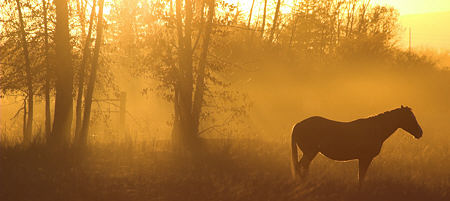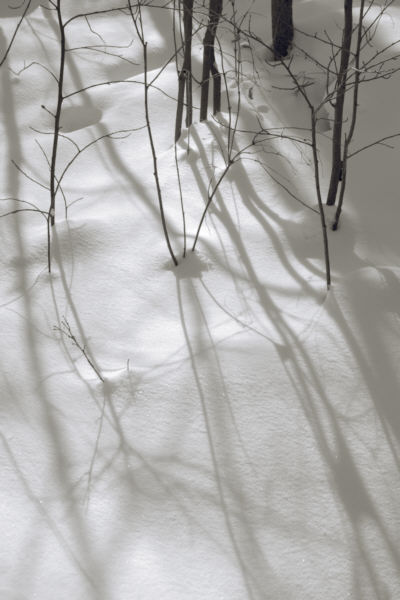
In a recent post, Hanneke looked again at a year-old painting she had felt dissatisfied with. I’m not sure how common this is for painters, but for me and, I suspect, most photographers, it’s the normal way of things. Whether blessing or curse, we have lots of older images that were not immediately pursued. Capturing an image takes much less time than bringing it to the standard of a fine print.
There is one advantage to this state of affairs, namely the enforced editing that prunes the large fraction of images that are, at best, less good than those we spend our limited time on. There might even be psychological benefit: if it’s good to learn to let go, I sure have a lot of learning opportunities. On the other hand, if regret is bad, I’m in trouble.
Whenever I look again at those horses backlit by a setting sun, I feel pain. It was the most amazing light I’ve ever seen. The image above is totally unmanipulated in any way. (That doesn’t mean it’s “exactly how it was” — whatever that is — but the digital camera and the program that converted to the image file shown had only standard, default settings for all parameters; I made no adjustments.) Unfortunately, a physical problem with such high-contrast lighting spoils the images with highlights in circular arcs in the grass (I’ve minimized it in the reduced image above, but find it disturbing in the originals.) Plus I was so entranced with the rapidly disappearing light that I did a lousy job of composing. If I ever find that light again…
Many images now in my portfolios, of course, have managed to make the leap from memory to reality. Others are on the cusp. Below is one from two years ago that I’ve re-viewed several times; last night I got as far as processing it to the point you see below (I haven’t tried to print it yet).

I remember making this photograph quite well, and I could easily write a haiku to help place it with others in the Sourdough Trail series. I have a feeling it might get there eventually, but I just haven’t yet viewed it in a frame of mind to make the commitment, so it remains in limbo.
Thinking about it, I realize (yet again) that photographers are not unique. Other artists have sketches, notes, even photographs of subjects that they hope to pursue at some later time. For example, David has mentioned his extensive notebooks. How often are old ideas and intentions brought back to life? Are they better for having waited?

Steve,
I have limited experience with photography, but the insight I got trying to make cloud photos here in Holland is that one must be patient: find the place and composition, then wait and wait and wait for the clouds and light to be right.
What I would love to see is a progression of processing stages for one of your photos, Steve. I’d like to be visually convinced that photography is more than just pressing a button. I’m teasing, obviously, but I’m serious about the interest in the development of the series.
In the past, artist drawings were considered to be of little value in themselves, beyond their use in making paintings. At a certain point in history, collectors became interested in drawings for their own sake. Perhaps the “half-finished” photos will one day be a collector’s item as well.
Absolutely beautiful. I am just a beginner but I would have put in a little more foreground :) This is why I have a habit of taking about four photographs of any one scene! and then I can crop as I like :)
Good point, Carol. I’d like to see a bit more by the horse’s legs.
Some time back Paul Butzi said that five-hundred photographs was a good number to cover a subject.
The same beautiful morning light that Ginger showed with her sandhill crane photo.
The filigree in the snow makes me look forward to winter.
Carol,
Maybe we have a similar compositional eye. As you might be able to tell from the image dimensions, this is a crop (from both top and bottom, and actually a bit on the right also) from an original that did have more foreground. But it also has most of the problem I alluded to, which I’ll demonstrate in a few minutes from my other computer, and which is mainly in the foreground. Hence the crop shown here. The legs are hidden by the grass, though
Karl,
An interesting difference from the drawings is that the latter are more abstract and show more baldly the hand of the artist than the original, whereas the opposite is usually true of unprocessed photographic captures.
Maybe so, Steve, but if we are looking not so much at the photos as at the differences among them, the comparison to drawing still holds.
Here’s a bit of the foreground and horse to show the annoying circular highlights centered on the sun:
It’s reflection from the dried grasses, which can be very shiny (no snow this time).
Karl, Yes about the differences, and your idea for a future post is a good one.
Steve:
Are you talking about those little dots of light scattered here and there?
the phenomenon of going-back-to can certainly be parsed a number of ways. For me there are those projects that I set aside for some external reason, like the weather. I then see something previously unnoticed upon return and pick up the work at a very different place from where I had left it. Then there are pieces that I doom to the scrap, but somehow don’t quite throw away. I thereupon come back to find a redeeming quality to develop. And, I cannot finish something at one go. I’m sitting here stumped, trying to think of one piece -just one – that hasn’t resulted from a process of setting aside for awhile.
My attitude at the point of setting aside, or otherwise consigning, makes a difference. There were some shots that I was Photo Shopping last night, while otherwise fretting about the Indians game. They’re bad and I know it, but they’re open to improvement and I shall return.
Jay,
Not just dots of light, but streaks of dots or dashes that are nearly continuous. In isolation, they might look like just single, brightly lit stalks of grass, but it’s the overall pattern concentric about the sun that is a problem.
True, almost nothing is finished in one go, but it’s pretty rare for me to go back to something that I intentionally dropped (as opposed to simply not having time for at the moment). There’s just too much else to do.
I sometimes work with photography as I do with my writing, meaning I take notes all the time and have gone anywhere from hours to years before they find their way into a poem. I also take photographs with little planning or effort and get ideas for other photos later on that will have more meaning for me. It’s also a way for me to clear my head a bit and then focus on what I really want to do.
I don’t see anything annoying about the arcs of light in the first photo. It looks really good.
Steve,
I really can’t see the problem? Streaks of dots? Are you talking about highlights on stalks of grass? Could you not post both cropped and original photos? It would be very interesting.
Carol,
Here’s the uncropped (but resized) image:
The problematic streaks (highlights on the grass, but in a particular large-scale pattern) are, to my eye, quite noticeable here, and on the enlargement of comment #9. They may bother me more than others. I’m glad you like it! I certainly enjoy it myself, even though I consider it spoiled.
Steve,
I like this un-cropped version. I don’t see the streaks as such a problem. It is the light that your are interested in, after all.
Much better
The foreground is a little bit dead I agree but I really prefer this to the cropped version! Try cropping a little left of the fence post taking out the left most tree and a little bit off the bottom and top (most of the very bright sky) and tell me what you think?:) I need to post you my version of a really brilliant photo!
Carol,
Your suggestion gives a nice composition around the horse, but I actually prefer cropping out the horse! Not that I don’t love horses. As I mentioned, I don’t think much of the compositions I captured that day, but in part it was because I intended to crop to a more panoramic format. Anyway, to post your version, or an image of your own, refer to the description in our Posting Guidance.